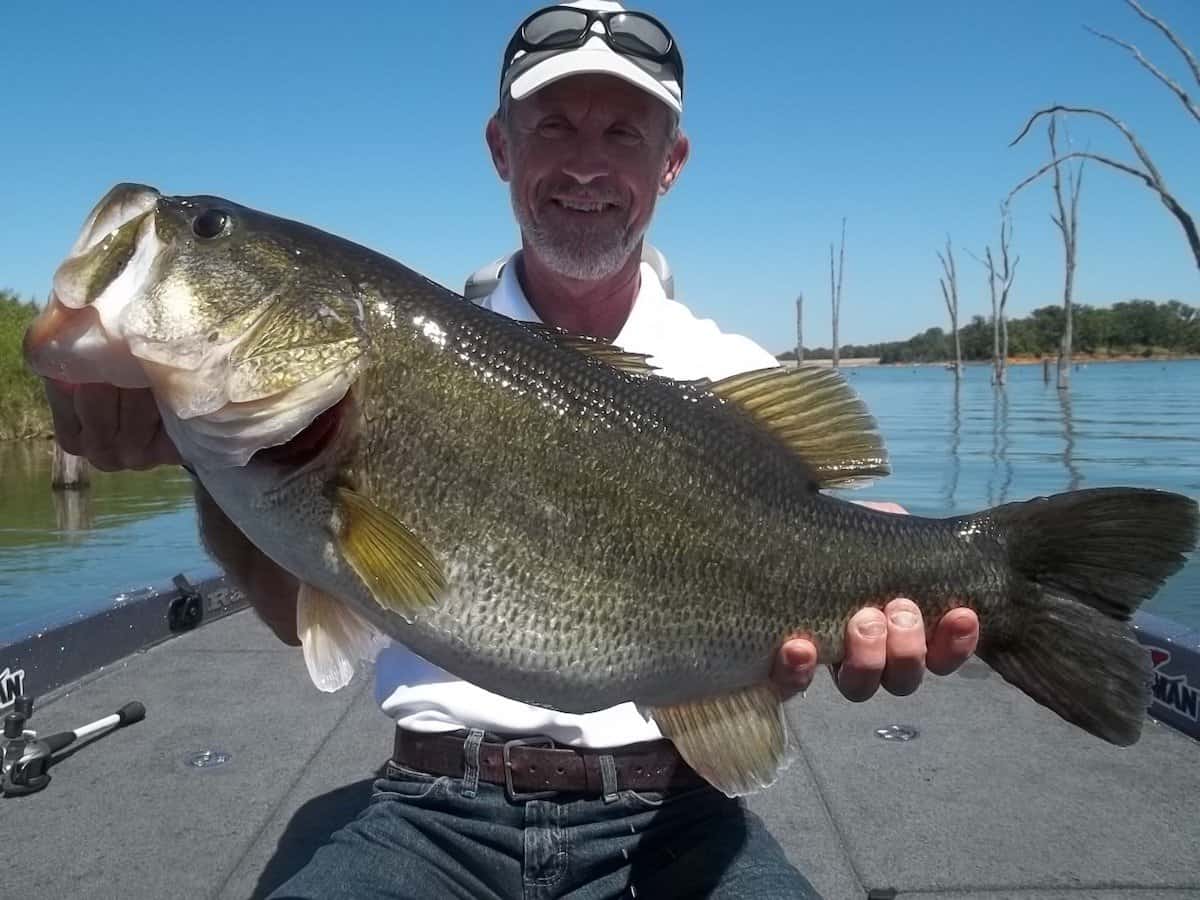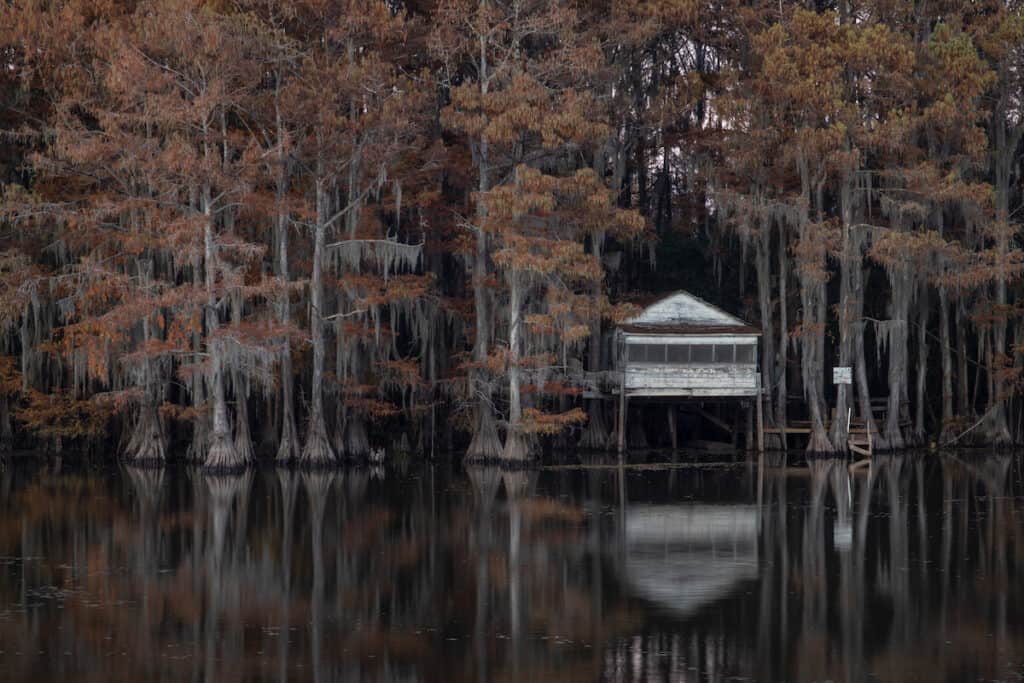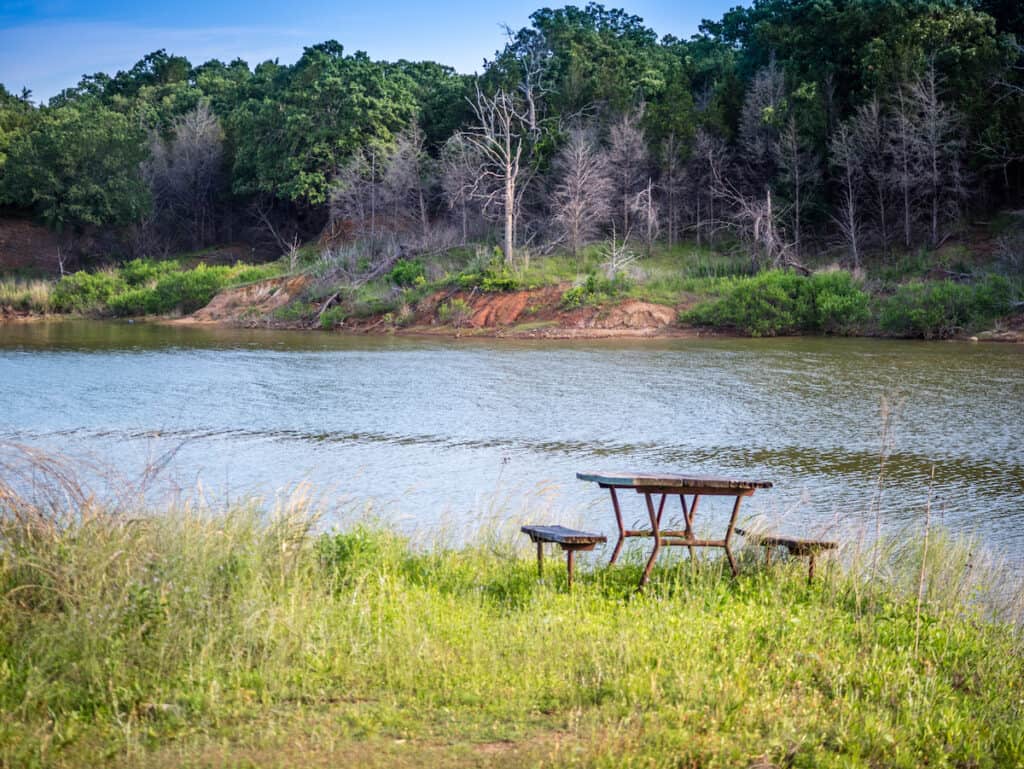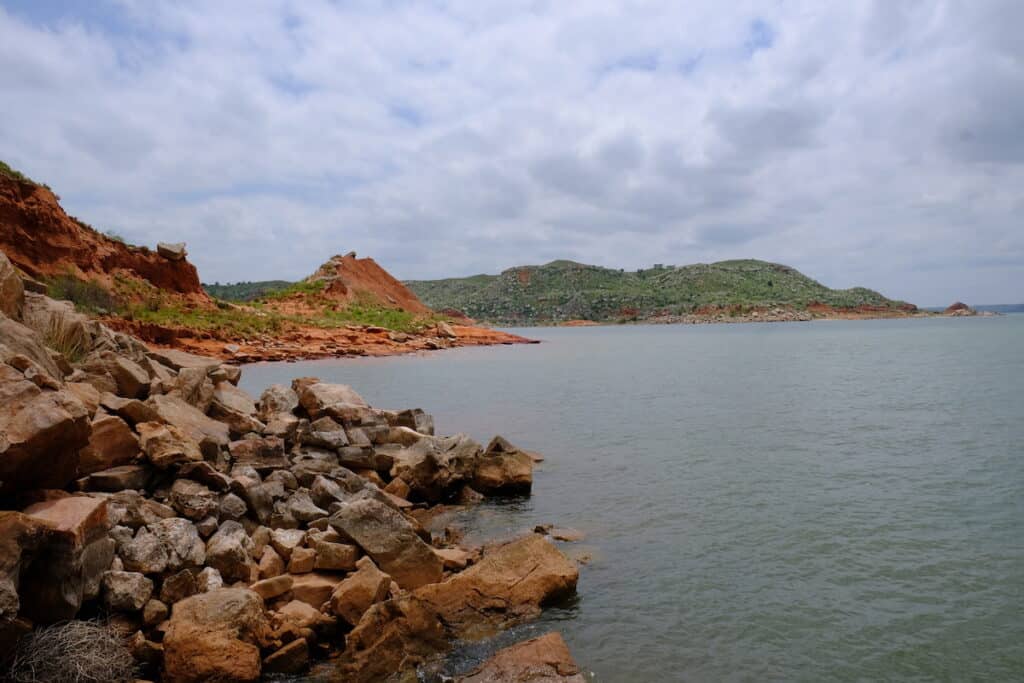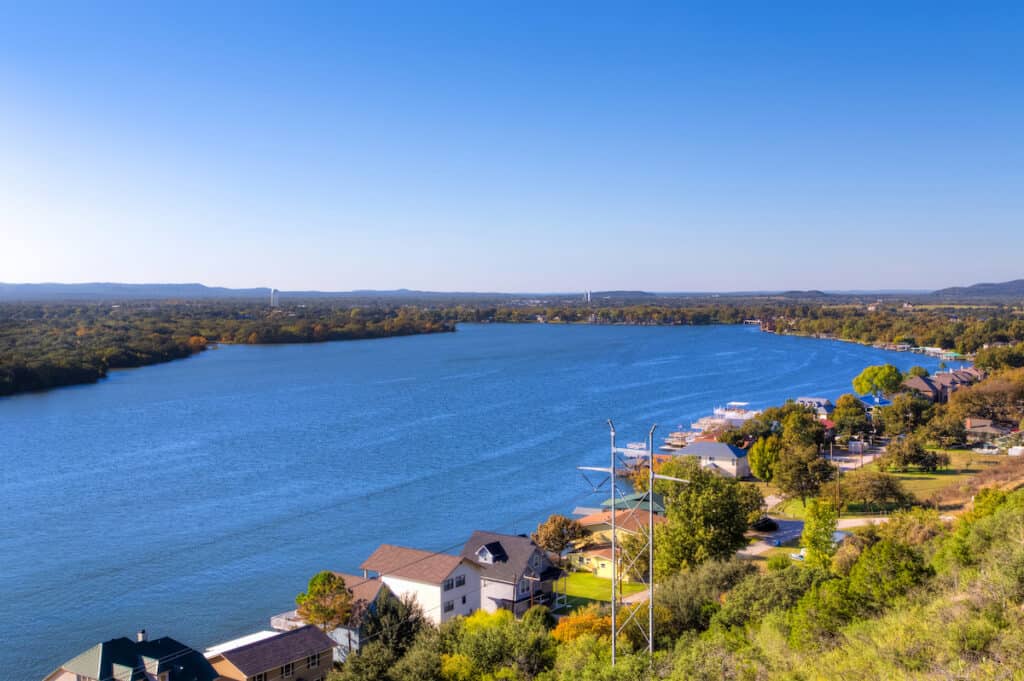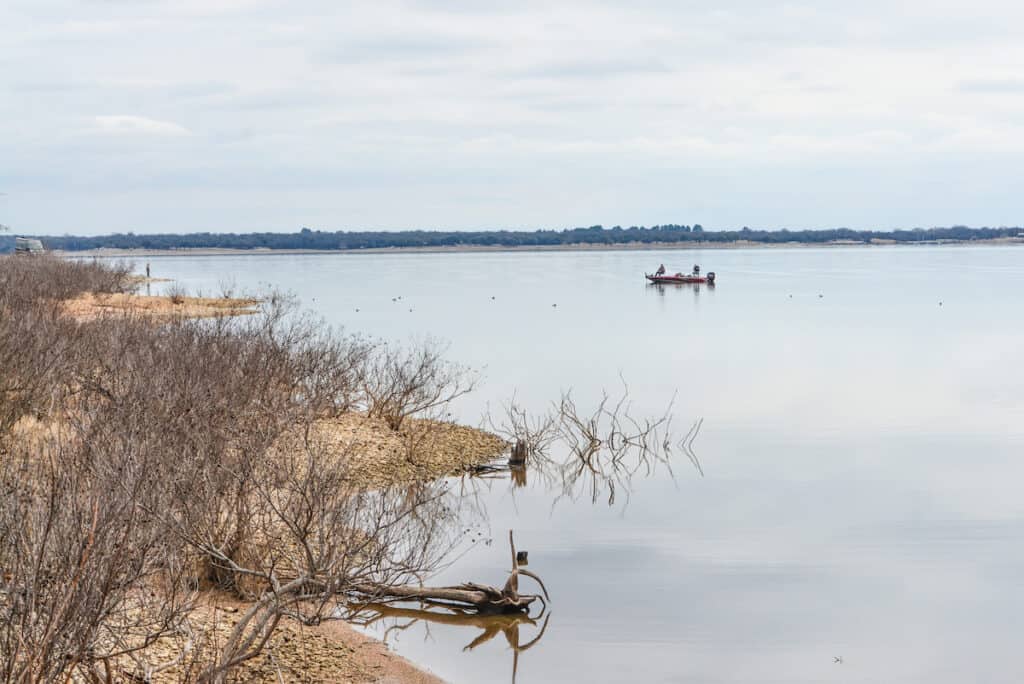Few states offer a greater wealth of bass fishing options than Texas. Some of the best bass lakes in America are right here.
Texas is a state where, as the saying goes, everything is bigger. That’s certainly true of largemouth bass, which commonly top 10 pounds in Texas lakes and reservoirs.
Before you leave, check out the 11 Biggest Bass Caught in 2023, at the bottom of this article.
Texas, it’s worth mentioning, also has some very good smallmouth and spotted bass fishing lakes. And a handful of waters in the central part of the state are home to Guadalupe bass, a species of black bass that can be caught nowhere else on earth.
If you want to know where to catch bass in Texas, then you’ve come to the right place. The following are the 21 best bass lakes in the Lone Star State.
Top 10 Texas Bass Lakes (+1)
Bass fishing is so good in Texas that even our Top 10 list has 11 lakes on it!
The following 11 locations are simply a bucket list of lakes for anyone and everyone who loves bass fishing and has the good fortune to fish for them in Texas.
Stick around for the next 10 lakes as well, because there are way too many great fishing holes in this state to contain within anything close to a Top 10 list.
Lake Fork
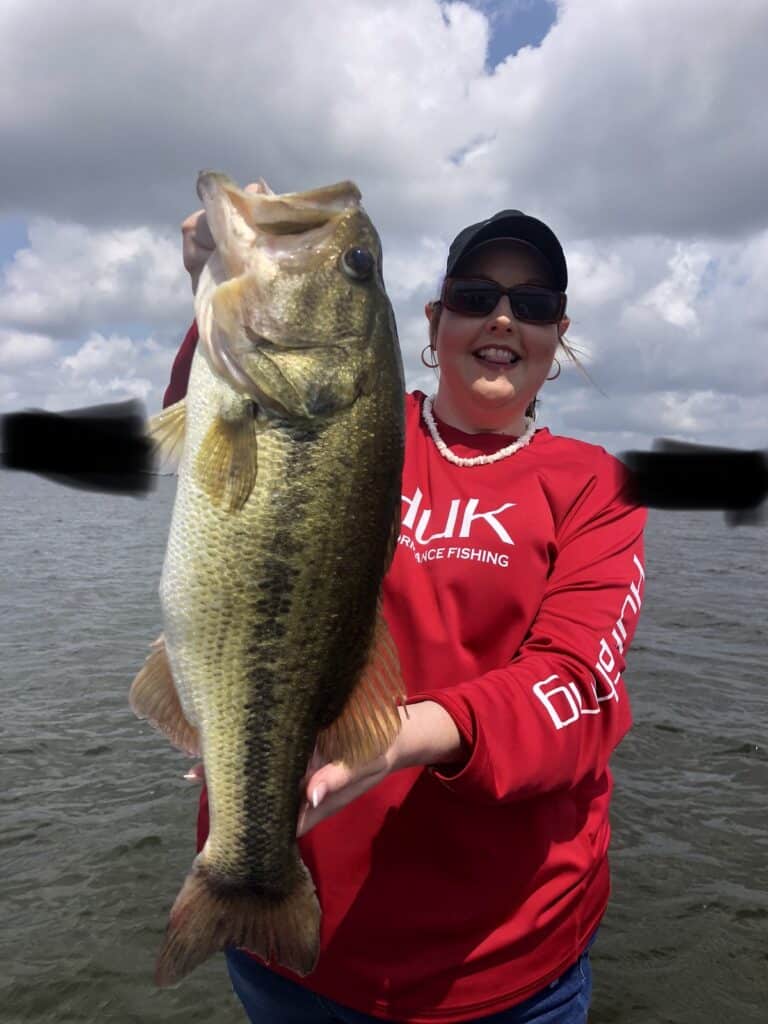
The name ‘Lake Fork’ is burned into the collective memory of many anglers. If you watched fishing TV shows or read fishing magazines in the ‘90s, you couldn’t go a week without hearing about another big bass caught in Lake Fork.
Of the 50 biggest bass ever caught in Texas, 30 of them came from Lake Fork, including the over 18-pound largemouth currently sitting atop the state record listing.
Most were caught during the lake’s glory years from around 1986 to 1993, but a 16-pound largemouth was caught here as recently as 2013, so Lake Fork is most definitely still in the game.
Lake Fork is a reservoir on a tributary of the Sabine River, spanning a little over 27,000 acres. It’s about 2 hours east of the Dallas-Fort Worth area, and remains an impressive numbers lake as well as a trophy bass fishery.
The water in Lake Fork is typically rather clear, and an abundance of aquatic vegetation grows here. Hydrilla and Eurasian milfoil form thick mats that bass love to hide under, and there’s a decent amount of timber up in the creek arms.
Boat houses, docks and bridge crossings are always worth a few casts too. Look for areas where structure and cover converge, like a rocky point that intersects the edge of a weed bed.
Crawfish and shad patterns do well in Lake Fork, so have jigs, creature baits and crankbaits at the ready. Big bass feed heavily on the crawfish as they emerge from their winter dens in early spring.
The Lake Fork Craw Tube is a locally-made lure that bass go nuts for.
Shad spawn in April and May, becoming the main forage species around this time. Worms and topwaters have their place in your arsenal as well.
Lake Fork often provides an evening topwater bite, and the night fishing can be excellent here in summer.
Lake Fork has dozens of boat ramps and shore fishing sites, including the W.C. Swearington Recreation Area, Highway 154 public boat ramp, and the 515 East boat ramp, among many others.
A restrictive slot limit is in place to maintain the fishery. Bass under 16 inches and over 24 inches must be released.
More: Complete Guide to Lake Fork Fishing
Sam Rayburn Reservoir
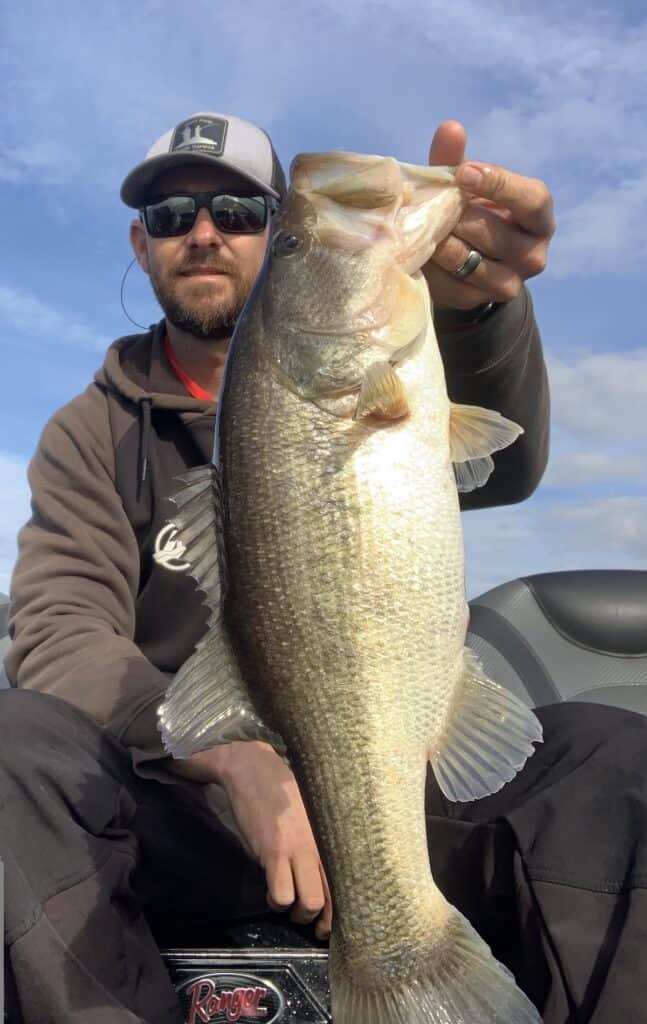
Spanning 114,500 acres, Sam Rayburn Reservoir is the largest lake that lies entirely within the state of Texas. It’s also a venerable bass factory that’s been churning out trophy largemouths for decades.
It’s a great numbers lake too, and the type of fishery where one can catch bass year-round. Sam Rayburn is also a place where your favorite fishing tactic, whatever that may be, has a good chance of connecting.
If you like chugging a topwater over beds of hydrilla, you can do that here. If you enjoy knocking jigs off standing tree trunks, that’ll work. If you’d rather toss crankbaits along rip-rap shorelines or flip creature baits around boat docks, go for it.
Sam Rayburn Reservoir has a little bit of everything.
Sam Rayburn Reservoir is primarily fed by the Angelina River, but it has dozens of creek arms of various sizes.
Creek mouths are great places to find big spawning bass early in spring, and the Prairie Creek and Boggy Creek areas are prime spawning grounds.
A lot of hefty largemouths have also come from the Stanley Creek arm, where there’s a ton of timber and brush.
The water in the upper portion of the lake and its various tributaries is often somewhat muddy, especially in spring, but the main lake usually has pretty good visibility.
Fishing the creek channel and areas of vegetation is usually most productive in the lower lake.
When the water warms up in summer, big bass slide deeper along main lake points. This is also a lake where bass sometimes congregate on seemingly-featureless flats for reasons that leave anglers mystified.
Sandy Creek Public Launch Ramp is a great launch spot mid-lake, and Rayburn Park offers access closer to the dam. All told there are more than 20 launch ramps around the lakeshore.
Sam Rayburn Reservoir also is one of the best catfish fishing lakes in Texas.
More: Complete Guide to Sam Rayburn Reservoir Fishing
Toledo Bend Reservoir
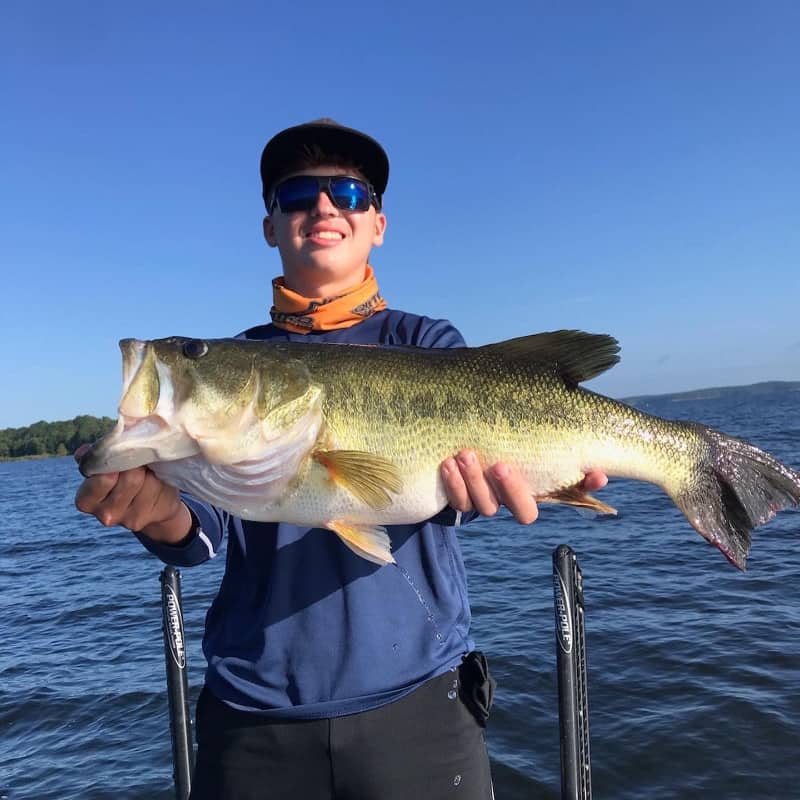
Toledo Bend Reservoir stretches along 65 miles of the Texas/Louisiana border, and at 181,600 acres, it’s plenty big enough to share. Bassmaster named it the best bass lake in America in both 2015 and 2016, and it’s almost always in the top 10.
Part of what makes Toledo Bend such a great fishing lake is its sheer size and variety of habitat. Though it’s primarily an impoundment of the Sabine River, it’s fed by hundreds of smaller tributaries, each forming its own creek arm or cove.
The lake’s size can be intimidating, too. Where to even begin?
For starters, the lake has a lot of standing timber, as well as sizable beds of hydrilla and other vegetation. Shoreline brush and vegetation is often flooded during times of high water.
These are all good cover for bass. Almost all of Toledo Bend’s Texas shoreline is made up of state park, national forest and wildlife management area land, offering dozens of launch sites and countless shore access spots.
Starting out by exploring shallow cover is always a smart move, and you can catch a lot of bass by tossing crankbaits and spinnerbaits in spring and fall.
The only time the fishing really gets tough is summer, but there’s still usually a topwater bite in the morning and evening.
It might also help to break down the lake into sections.
The lower (southern) half of the lake is generally deeper and clearer, with distinct creek channels and weed edges. The upper lake is shallower and a bit muddier, with less plant life and more woody cover.
The upper end also warms up more quickly in springtime, and bass may spawn a month or more earlier than their counterparts at the lower end. That gives anglers a wide calendar window in which to take advantage of prime fishing.
Toledo Bend also has multiple other great fishing options, including being one of the very best crappie fishing lakes in Texas.
More: Complete Guide to Toledo Bend Fishing
O.H. Ivie Lake
O.H. Ivie Lake has always been a perfectly respectable bass lake. But sometimes, for reasons no one completely understands, a lake that’s just been minding its business for years will suddenly explode. That’s what happened to O.H. Ivie in 2021.
Over the course of February and March 2021, the Texas ShareLunker Program recognized twelve bass weighing 13 pounds or more from O.H. Ivie Lake. Twelve. That’s crazy. For those two months, this was probably the best bass lake in America.
The lunker train didn’t stop in 2021, as anglers landed largemouth bass just over 17 pounds at O.H. Ivie Lake in February 2022 and again in February 2023. Both fish were the heaviest bass that ShareLunker listed for their respective years.
In 2023 alone, the lake produced a remarkable 21 bass over 13 pounds; all other Texas lakes combined mustered eight bass over that mark, according to ShareLunker data.
That behemoth was the largest bass officially recorded in Texas during the 21st Century (seventh largest overall) and the biggest bass Texas Parks & Wildlife has recorded anywhere in Texas other than Lake Fork.
Those massive fish make a great argument that O.H. Ivie Lake is currently the best lake in Texas to land a trophy largemouth bass. In fact, it’s one of the best in the U.S. at this time.
O.H. Ivie Lake is a 19,100-acre reservoir on the Colorado and Concho Rivers, out in middle-of-nowhere West-Central Texas.
The trees and brush were not cleared from the basin when the lake was impounded in 1990, so there’s a lot of cover for bass to inhabit.
In particular, thousands of acres of flooded oak, mesquite and juniper trees provide cover throughout the reservoir. There is also prolific growth of salt cedar along the edges of the lake, which become inundated at times of high water.
Weedless jigs are popular for fishing among the tangled brush and trees here, and soft stickbaits are effective as well. Try an oversized worm for pre-spawn bass, or crankbaits and topwaters later in spring and early summer.
The spawn typically takes place in March, though unpredictable spring weather in this part of the state can make it tough to predict. The upper end of the lake and river arms, which are dominated by flats, are usually good for spawners.
The deeper, rockier lower lake is better once the water warms up.
The Colorado River Municipal Water District operates three recreation areas around O.H. Ivie Lake—Concho Recreation Area, Padgitt Recreation Area, and Kennedy Recreation Area—each of which includes boat ramps, campsites, docks and shore access.
Lake Conroe
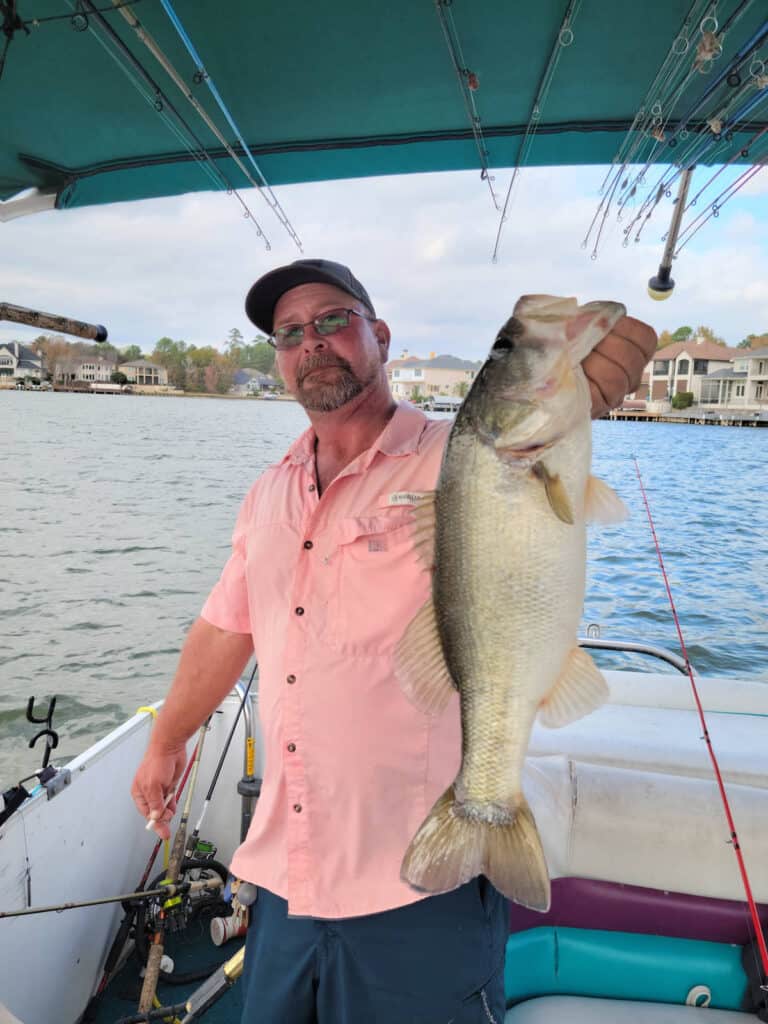
A 21,000-acre reservoir, Lake Conroe is consistently among the best bass lakes in this part of Texas as well as best catfish fishing lakes in the Houston area.
Less than an hour outside the city, this is a lake that delivers in both quality and quantity, and typically produces multiple 8-pound-plus bass every year.
Lake Conroe is a diverse lake, with several distinct types of structure.
The lower lake is the deepest, dominated by open water and relatively sparse natural cover. It does, however, have a ton of boathouses, floating docks and bulkheads that can be a lot of fun to fish.
This is about as good as it gets for anglers who like to pitch and flip soft plastics around docks. The best docks and piers tend to be the ones that reach out into deep water near main-lake points.
The upper arms of the lake have a bit more vegetation, as well as some extensive areas of standing timber and flooded brush. Bass have a lot of places to hide up here, but fluctuations in water level can also create a lot of boating hazards.
Try working topwaters and soft plastics around emergent water willow and torpedo grass in backwater areas.
A lot of Lake Conroe’s timber grows right alongside the old creek channel, and tons of bass are caught on spinnerbaits, cranks and jigs among the trees.
As is often the case in Texas, February and March are the best time to find big bass in shallow water.
Depths under 15 feet can be productive well into summer, but you’ll catch smaller bass here once the big ones move deep after the spawn.
You have a lot of launch sites to choose from, both public and private.
Cagle Recreation Area provides launch facilities, shore access and camping on the upper lake within Sam Houston National Forest.
The FM-830 Boat Ramp is a great place to launch for free on the lower lake.
More: Complete Guide to Fishing at Lake Conroe
Lake Ray Roberts
Arguably the best bass lake in the Dallas-Fort Worth area, Lake Ray Roberts is a 25,6000-acre Trinity River reservoir, located just north of the DFW Metroplex. It has two main arms and an abundance of bass-friendly cover.
Overall, Lake Ray Roberts has a reputation for producing huge bass, but also for being difficult to fish. It often takes time to figure this lake out, but putting in the work can pay off big time.
Part of the challenge comes from fishing pressure. Lake Ray Roberts is one of the best fishing lakes in the state, and it’s right next to the most populated area in Texas, so you can probably do the math.
Finding an unknown spot or throwing something the fish haven’t seen before is often the key.
That being said, there are a few tried-and-true patterns.
Fishing rip-rap can be productive. The lake has several major bridge crossings, and they can yield some decent fish. The rocky face of the dam often gives up a few bass as well.
The biggest bass of the year are usually caught here in late winter and early spring, when big, egg-laden females head toward shallow areas in preparation for the spawn.
Backwaters of Ray Roberts’ many creek arms are good places to target in March.
Aquatic vegetation is sparse, but where available, patches of chara, milfoil, pondweed and hydrilla typically harbor bass.
Lake Ray Roberts also has around 2,000 acres of standing timber, which can be some of the best cover to target on this lake. Try working jigs between the trees, or zipping a crankbait among the trunks.
Lake Ray Roberts has a lot of prime access areas. Several public launch sites are available, as well as a shore fishing site at the dam.
Ray Roberts Lake State Park offers camping as well as fishing and boating access.
Caddo Lake
Another Texas/Louisiana border reservoir, Caddo Lake has yielded some of the biggest bass ever caught in either state.
Between 2009 and 2011, three bass weighing 15.1, 16.06, and 16.17 pounds were caught here. Those are some big fish.
Largemouths of such proportions are an extreme rarity, even here, but Caddo Lake remains a decent place to set your sights on a 10-pounder.
It also has a healthy, balanced bass population, with plenty of smaller and mid-sized fish to keep your rods bent.
Caddo Lake is a 26,800-acre reservoir on Big Cypress Bayou. The lake has an abundance of aquatic vegetation, and many shallow areas are dominated by cypress trees. It’s a unique and beautiful place to fish, with plenty of prime bass habitat.
It’s also quite a shallow lake, with maximum depths around 20 feet. Bass usually spawn in March, and post-spawn patterns last through May.
By mid-summer, though, water temperatures are often in the upper 80s, and vegetation covers 95 percent of the surface. Fishing can be very tough this time of year.
Basically, spring and fall are the best times to fish Caddo Lake. Skirted jigs, soft jerkbaits and floating frogs are some of the best lures, and square-billed crankbaits are great early in the year, when there’s enough open water to use one effectively.
Fishing around the inundated cypress trees is a fun and effective way to fish.
Caddo Lake has a lot of submerged hazards—it’s worth investing in a good quality map—and smaller craft like canoes and kayaks are often best able to navigate the tree-filled backwaters.
Bank fishing is generally limited by the wild, undeveloped nature of much of the shoreline, but there are a few spots around the lake.
Caddo Lake State Park provides boat launch facilities, a fishing pier, and campsites near the water.
Caddo Lake also is a great spot for bluegill and sunfish fishing.
Falcon International Reservoir
Falcon International Reservoir—often referred to as Lake Falcon—is a vast border reservoir on the Rio Grande. Encompassing around 83,000 acres, it’s an incredible bass lake shared by Texas and Mexico.
This is a lake where it takes a string of 5-pound-plus bass to even think about winning a tournament.
Falcon International reservoir gave up multiple 10-pound bass in 2019 and 2020, and while it may have fallen a bit from its peak since then, it’s still a lake to be reckoned with.
Falcon is a mostly shallow lake, though there are hundred-foot depths near the dam.
The water is moderately stained throughout much of the lake, but can be quite turbid at the upper end. The best fishing spots change depending on current water levels.
During times of drought and low water, standing timber and rocky reefs that are ordinarily submerged become visible at the surface, providing prime targets for anglers.
When the lake is higher, inundated vegetation around the shoreline is usually where the bite is.
Carolina and Texas-rigged soft plastics are great baits for plying vegetation and brush.
Crankbaits and spinnerbaits that imitate the lake’s threadfin shad are usually effective for working deeper structure and less snaggy cover.
Falcon International Reservoir is the southernmost major reservoir in Texas, and the fishing calendar starts early here. Water temperatures usually warm up to 60 degrees by the beginning of February, and bass typically spawn around that time.
By mid-summer, daytime temperatures are often punishingly hot, and bass retreat to deep structure, and the best fishing will be in the deeper, southern end of the lake.
Access is available near the dam at Falcon State Park, which also offers ample shore fishing access on the American side of the reservoir.
Lake Texoma
A vast reservoir on the Texas-Oklahoma border, Lake Texoma sprawls across more than 74,000 acres. It’s home to largemouth, smallmouth and spotted bass, and is one of the best places in Texas to catch all three on the same trip.
Aside from a few isolated areas of water willow, American lotus and pondweed, aquatic vegetation is largely absent from Lake Texoma.
The best approach here is to start with a topographic map, and base your approach on reading bottom structure.
Look for bluffs, points, reefs, channel drop-offs and ledges, especially where they intersect with fishy cover like standing timber and rip-rap. Of the lake’s 580-mile shoreline, there are about 50 miles of standing timber and 9 miles of rip-rap.
As you might guess, these areas get hit pretty hard by anglers.
Dock fishing in the more developed areas can also be effective, and there are some excellent rocky shores and bluffs, especially in the lower lake.
Bass typically spawn in April (sometimes as late as May after a cold spring) but bass can truly be caught year-round. That being said, spring is prime time.
Focus on shallow cover with crankbaits, jerkbaits and topwaters, and then look toward deeper cover in summer with jigs and drop-shot rigs.
Largemouth and spotted bass inhabit areas throughout Lake Texoma—they’re especially fond of standing timber—but smallmouths are mostly restricted to the lower lake.
Rocky banks and bluffs from Eisenhower State Park down to the rip-rap-lined Denison Dam are great for smallies.
A Texas fishing license allows anglers to fish only the Texas portion of Lake Texoma, so maintain awareness of where the line is. For an additional fee, one can also purchase a Texoma fishing license, which opens up the entire lake to fishing.
Lake Texoma makes a lot of “best of” fishing lists, including ours for best striped bass fishing in Texas and best catfish fishing near Dallas-Fort Worth.
Not surprisingly, given its location on the state line, Lake Texoma also is among the best bass fishing lakes in Oklahoma.
More: Lake Texoma Fishing
Lake O’ the Pines
Nestled in the northeast corner of the state not far from Texarkana, Lake O’ the Pines is a great lake for both numbers and quality of fish.
A few 8-pound-plus largemouths are caught here every year, and the lake produces tremendous numbers of smaller bass in the 2-pound class.
Lake O’ the Pines is a man-made reservoir on Big Cypress Creek in the Cypress River Basin, and the lake is close to 20,000 acres at full pool. It’s a very picturesque lake with wooded shorelines and plenty of creeks and coves that harbor fish.
Aquatic vegetation is very prolific here. Hydrilla is widespread, along with buttonbush, water primrose and lotus.
At times, weed growth can overtake up to 20 percent of the lake’s surface. Knowing how to fish in and around the slop is essential, especially in summer.
Due to its relatively northerly latitude, Lake O’ the Pines is a little cooler than most Texas lakes, and the spawn occurs a little later. It’s common for bass to spawn in April, and to see good post-spawn action well into June.
The water is often high in spring and summer, and when it is, flooded timber and brush around the shoreline provides some of the best fishing. Try jigs, crankbaits, topwaters and Texas-rigged worms close to the bank.
A wacky worm or finesse jig often does the trick when bass are reluctant to bite. Lake O’ the Pines is often drawn down in winter, and may be around 4 to 8 feet lower than in summer.
Anglers can choose among more than 20 U.S. Corps of Engineers launch sites around the shoreline. Among them are the Cedar Springs Boat Ramp at the upper end of the lake, Pine Hill Boat Ramp on the south shore, Alley Creek Boat Ramp on the north shore, and Overlook Point Boat ramp near the dam.
Amistad Reservoir
Located 3 hours west of San Antonio along the Mexican border, Amistad Reservoir is an incredible bass fishery. This 64,900-acre impoundment on the Rio Grande has become the stuff of bass fishing legend.
Amistad is typical of large desert reservoirs in that its shoreline is mostly dominated by rocky, often steep banks.
The water is often crystal clear, which makes it a fun lake to sight-fish for fat pre-spawn bass in February. But it can also be challenging. When you can see the fish, the fish can also see you.
It’s possible to catch solid numbers of bass in just about every size class, so tailor your approach to what you want to catch. For trophy bass, oversized lures are often most effective.
Look for giants in areas where a main lake point intersects a bed of hydrilla. As a general rule, big bass favor big water on Amistad Reservoir after the spawn, while smaller bass gravitate toward secluded coves and backwaters.
There’s a decent amount of timber and brush in the backs of Amistad Reservoir’s many coves and creek arms. Casting finesse soft plastics around stick-ups is a great way to fill your livewell with scrappy 2- and 3-pound bass.
Shoreline development is minimal on Amistad Reservoir, but the lake’s two main bridge crossings are major landmarks that can be good starting points for anglers. There are some old submerged road beds under the surface too.
The main access to the lake is through Amistad National Recreation Area, which includes several launch sites on the eastern half of the lake. Most of the shoreline is also open to bank fishing, though getting to a good spot often requires a hike.
Honorable Mentions
I’m guessing that you’ve probably heard of most of the lakes we covered above. After all, more than one of them are world famous for bass fishing.
The next 10 reservoirs on this list may not get into the spotlight quite as often, but these are lakes that at times can rival any bass lake in America. And if they’re close to where you live or where you’re going to visit, all the better to get to know them.
So check the following out, and get in some fishing if you can.
Choke Canyon Reservoir
One of the very best bass lakes near San Antonio and across South Texas, Choke Canyon Reservoir is a 25,600-acre reservoir just over an hour south of the Alamo City.
There’s no other lake in this part of there state where you’re more likely to boat a 10-pound bass.
Among Choke Canyon Reservoir’s many charms is its diversity of structure and habitat. You’ll find steep banks, long sloping points, beds of hydrilla, groves of standing timber, rip-rap shorelines—plenty of places where bass can live life to the fullest.
That gives anglers a lot of options. One of the southernmost bass lakes in Texas, Choke Canyon often sees bass on their beds as early as late January and definitely by February.
The months of March through May offer consistent post-spawn fishing in which bass bite readily at a wide range of depths.
Bass feed heavily on shad and crawfish in Choke Canyon Reservoir. A lot of different lures can do the trick, but the most effective are almost always shad-imitating spinnerbaits and jigs with crawfish trailers.
Hydrilla is where the biggest bass like to hang out, and you have a real shot at tangling with a giant if you run a silver/white double willowleaf-blade spinnerbait along the edges of weed beds, or right over the top of submerged vegetation.
Jigs work well in timber-filled coves and along main lake points.
Choke Canyon State Park is the primary access point on the lake, offering campgrounds as well as boat ramps and shore access in several different units around the shoreline. Watch out for alligators. And snakes.
Lake Meredith
Lake Meredith provides the best bass fishing in the Texas Panhandle, and this 16,400-acre oasis north of Amarillo is a productive lake for both largemouth and smallmouth bass. It’s also one of the few lakes in the state where walleye are stocked consistently.
Smallmouths are actually the more common black bass species here, and they thrive in Lake Meredith’s rocky habitat. In fact, the state record smallmouth bass weighing nearly 8 pounds was caught here.
The lake has steep banks and deep water, which ranges from quite clear at the lower end to highly turbid at the upper end.
The best smallmouth fishing is around rocky drop-offs, reefs and points. They’re often caught close to rocky banks on crawfish imitations.
Keep an eye on water temperatures in spring; the smallmouth fishing goes into high gear when temps cross the 60 degree mark.
Smallmouths can be caught all through summer in Lake Meredith, though deeper water is more productive at that time. Lake Meredith is prone to dramatic fluctuations in water level, so the best fishing spots are likely to change.
Largemouth bass tend to be somewhat restricted by habitat. A few backwater areas have vegetation and limited areas of timber, and these are the best places to target largemouth bass. Forage species include bluegill, gizzard shad and crawfish.
The lake is entirely surrounded by Lake Meredith National Recreation Area, and multiple boat launch facilities, shore fishing areas and campgrounds around the shoreline are operated by the National Park Service.
Lake Lyndon B. Johnson
One of the most reliable bass lakes in the Texas Hill Country, Lake Lyndon B. Johnson is about an hour west of Austin. The lake encompasses a little less than 6,500 acres, making it a modest-sized lake that offers a wide range of options.
Pre-spawn is a great time to be on Lake LBJ. Bass head shallow in February most years, and gradually start to bed down for the spawn in March and April. Head to the coves, canals and creek arms early in the season to catch some of the biggest bass of the year.
Backwater areas of the lake have a lot of flooded water willow and spatterdock, which provide good bass action on soft plastics.
You can usually find bass fairly shallow right up through May, but in summer when they transition deeper, they’ll bite on tubes and diving crankbaits on points and drop-offs.
The water clarity in Lake Lyndon B. Johnson is usually quite good, and the lake level doesn’t fluctuate too much. There’s a lot of shoreline development, so it’s a great place to drift slowly along the shoreline, pitching and flipping to docks as you go.
Various brush piles and fish habitat structures have also been sunk in Lake LBJ, though their locations are often a tightly-guarded secret among local anglers.
In winter, the best fishing is near the warm water discharge from the power plant overlooking Horseshoe Bay.
The main public launch ramps on Lake LBJ are located at McNair Park and Kingsland Community Park. Several privately owned marinas also offer launch facilities, but shore fishing access is generally quite limited outside of a few parks.
Lake Alan Henry
A far-flung reservoir between Lubbock and Abilene, Lake Alan Henry is well off the beaten path for most Texas anglers. For a long time, this lake had a reputation as Texas’ “secret” bass lake, but at this point, it’s safe to say that the secret is out.
Since around 2010, Lake Alan Henry has been one of the state’s most reliable producers of big bass. The lake record stands at a hefty 15 pounds, and although catch rates for largemouths aren’t as high as elsewhere in the state, there are some seriously big bass here.
Lake Alan Henry is a very long, narrow reservoir that covers 2,880 acres and has multiple creek arms and inlets. The shoreline is steep in most places, and the primary cover is rock and flooded timber.
The best bass fishing is usually in March and April, when water temperatures are in the 55- to 60-degree range.
Come armed with crankbaits, plastic worms and spinnerbaits. The water clarity ranges to mostly clear to murky depending on the lake level and recent rains.
Lake Alan Henry also has a substantial population of spotted bass. Though smaller than largemouths, spots are a great option for anglers more interested in numbers than size. They are most abundant in the lower end of the lake, towards the dam.
Sam Wahl Recreation Area provides the best access to Lake Alan Henry, including launch facilities, a fishing pier and docks, and a campground for tents and RVs.
Stillhouse Hollow Reservoir
About an hour north of Austin, Stillhouse Hollow Reservoir is an exciting mixed-bag fishery for both smallmouth and largemouth bass. It’s a 6,400-acre lake with clear water and an abundance of rocky habitat.
Largemouths are the more common bass species, and they inhibit areas of brush and timber toward the upper end of the lake. The lower lake also has some beds of hydrilla that can be productive for largemouths.
Try running topwaters over submerged beds of hydrilla. Once the weeds reach the surface, you can target largemouths using football jigs to punch though the vegetation.
Smallmouth bass, on the other hand, prefer rocky habitat, and are most common around rocky points and rip-rap.
Quite a few smallies are caught near the dam on jigs, grubs and tubes. Focus on 15 feet of water or less in spring, and then head deeper along ledges and drop-offs in summer. Even in winter, you can catch bass on drop-shot rigs and deep jigging.
Stillhouse Hollow Reservoir has very little shore development.
The lake is managed by the U.S. Corps of Engineers, who operate six access sites around its shoreline. Stillhouse Park, Dana Peak Park, Union Grove Park and River’s Bend Park all offer launch facilities.
Lake Palestine
Lake Palestine is located just outside the city of Tyler, about 90 minutes east of Dallas. Spanning a little over 25,000 acres, it’s a popular bass lake and a mainstay of the local tournament scene.
Though true giants are rare, Lake Palestine produces a lot of largemouths in the 5- to 8-pound range. There’s also a decent spotted bass population here, though they rarely exceed 2 pounds.
Highway 155 crosses the lake around its midpoint, and the bridge can be used as a general guide to divide the lake into two very different sections. Most of the lake’s timber and vegetation is above the bridge, especially in the Highsaw, Ledbetter, Kickapoo and Neches River Arms.
The main lake below the bridge is largely devoid of natural cover, though many artificial brush piles have been sunk throughout the area.
The bridge itself can be a productive area to fish, and many bass are caught around the bridge pylons and rip-rap.
Shad are bass’ main forage in Lake Palestine, and the best lures are often spinnerbaits and cranks that mimic threadfin and gizzard shad.
Jigs and soft plastics are great in timber-filled upper lake coves.
Lake Palestine’s shoreline is highly developed, and anglers have more than a dozen launch sites to choose from. The Lakeway Harbor Boat Ramp is a good launch site close to the 155 Bridge. The Kickapoo Boat Ramp is a good spot farther uplake.
Lake Palestine also harbors a very good fishery for white bass that run up into the Neches River.
Lake Whitney
A 23,500-acre reservoir on the Brazos River, Lake Whitney is located between Waco and Fort Worth. It’s a beautiful lake with a wide variety of public access—including several Corps of Engineers parks—that makes it a popular place to wet a line.
Lake Whitney is more of a numbers lake than a trophy bass lake, but a lot of 5-pound-plus largemouths are caught here, and the lake offers a lot of shoreline vegetation, bluff banks and timber.
It’s a great place for anglers who like to beat the banks with soft plastics, crankbaits and jigs. Bass are usually in less than 15 feet of water from March through May. In summer, 10- to 20-foot depths are more productive.
Lake Whitney has historically been one of the best smallmouth lakes in Texas (eight of the top 10 biggest smallmouths ever caught in Texas came from here). The population crashed in the late 90s, but the TPWD has been rebuilding the smallmouth fishery through stocking.
The section of the Brazos River below the Lake Whitney Dam is also a productive area for both smallmouth and largemouth bass. Kayaking on the river is popular as well.
Lake Whitney also is among the best striped bass fishing lakes in Texas, thanks to its consistency.
Pinkston Reservoir
Pinkston Reservoir (often referred to as Lake Pinkston) is a small lake that spans just 523 acres.
It’s way out in the East Texas Piney Woods, and with a location in-between Toledo Bend and Sam Rayburn Reservoirs, it’s not hard to see why Pinkston is often overlooked.
But this little lake punches well above its weight class when it comes to big bass. The lake record is an impressive 16.9 pounds, and a 14- to 21-inch slot limit is designed to let big bass grow even bigger.
The water at Pinkston tends to be very clear, and there’s an abundance of aquatic vegetation that bass use for cover. Look for a point or creek channel with good weed growth, and bass are likely to be around.
Try fishing plastic worms and jigs around the edges of vegetation.
This is a great spring and fall lake, when cool waters keep bass active and anglers often see fast and furious action on crankbaits and spinnerbaits.
Summer can be tough here, but there’s often a topwater bite early in the morning and again close to sundown. Try a soft jerkbait to tempt tight-lipped summer largemouths.
The shoreline of Pinkston Reservoir is mostly undeveloped, and access sites are located at the dam and at Sandy Creek.
This is a perfect lake for anglers who enjoy fishing from a float tube or kayak.
Lake Austin
A long, meandering reservoir along the Colorado River, Lake Austin is one of the best fishing destinations in the city that shares its name. Multiple bass weighing 8 pounds or more are brought to the boat every year.
Lake Austin offers 1,600 acres of water, and it often fishes more like a slow-moving river than a lake.
Weed beds along the shore provide ample cover for bass, and there are also a lot of boat docks. Flipping soft plastics under docks accounts for some great catches.
Creek mouths like Bee Creek and Bull Creek are also productive spots, especially in spring. Lake Austin has a highly developed shoreline, but a few untouched areas of rocky bluffs remain, with rockslides and shoreline boulders that may hold bass.
The best shot at a trophy largemouth is early in the year. Bass spawn at various times from February to April, and the spawn is noticeably later at the upper end of the lake, which is kept cooler by water releases from the Mansfield Dam upriver.
Because of its urban location, Lake Austin has a lot of boat traffic, especially in summer, that can make fishing very difficult. Try to get here as early as possible in summer to beat the crowds.
Emma Long Metropolitan Park is one of several parks along Lake Austin, and it offers boat ramps, a campground and some bank access. Shore fishing is generally limited on Lake Austin, but parks like Emma Long and Selma Hughes Park provide some access.
Fairfield Lake
A little less than 2 hours southeast of the DFW area, Fairfield Lake has seen its ups and downs over the years. The lake saw a series of catastrophic fish kills between 2008 and 2013, but Fairfield Lake has bounced back in a big way.
Anglers have been catching a lot more largemouths here in recent years, and 2021 saw more than 20 Fairfield bass donated to the Texas ShareLunker program.
Fairfield is a 2,100-acre lake with a mostly wild shoreline.
There’s a lot of flooded timber in the upper end of the lake, and you can often catch bass in spring and fall around the trees using jigs, creature baits and a variety of soft plastics. Bluegill, crawfish and shad all contribute to bass’ diet here.
Fairfield Lake also has a solid ring of hydrilla and other vegetation that grows around the shoreline. Much of the lake develops a 5-foot fringe of weed growth, and many anglers catch bass around its outer edge.
Historically you could access the water through Fairfield Lake State Park, but check its current status because at last look the park had been closed.
This lake used to have a unique warm-water winter fishery thanks to the power plant discharge at the north, and, but the plant was shut down in 2018.
11 Biggest Bass Caught in 2023
We assembled the following table in early 2024 using last year’s data from the Texas ShareLunker Program.
The following 11 bass all topped 14 pounds. A total of 29 bass entered in the program were at least 13 pounds, qualifying for the program’s Legacy or Legend categories.
If you, too, want to catch a massive largemouth bass, consider the following:
- More than two-thirds of the bass in those two categories came from O.H. Ivie, which in recent years has been the best Texas lake when it comes to absolute trophies.
- February was the best month for big bass, accounting for six of the following 11 largest catches.
| Weight | Location | Angler |
|---|---|---|
| 17.03 lbs | O. H. Ivie | Jason Conn |
| 16.65 lbs | O. H. Ivie | Shawn Strength |
| 14.85 lbs | O. H. Ivie | Leroy Boss |
| 14.76 lbs | O. H. Ivie | Dalton Smith |
| 14.5 lbs | O. H. Ivie | Brandon Vaughan |
| 14.4 lbs | O. H. Ivie | Dan Woods |
| 14.4 lbs | Alan Henry | Buddy Drake |
| 14.1 lbs | J. B. Thomas | Gardner Reynolds |
| 14.08 lbs | O. H. Ivie | Mechelda Criswell |
| 14.02 lbs | Toledo Bend | Toledo Bend Lunker Bass Program |
| 14.01 lbs | O. H. Ivie | Brad Mabry |
You might like this: 11-year-old Boy Shatters Lake J.B. Thomas junior record with 13.31-pound ShareLunker Legacy Bass. His dad also caught one of the biggest bass in Texas history just two years earlier.

